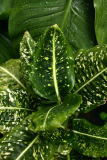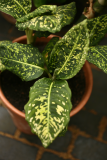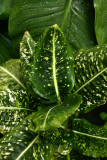Additional notes (click to expand)
Commemorative
The type plant of the genus was named Arum seguine in 1760 from a plant collected by the missionary Charles Plumier (1646–1704) in 1693. This was corrected when the current genus name, Dieffenbachia, was given by Heinrich Wilhelm Schott (1794–1865) in 1829. Named for a head gardener, Joseph Dieffenbach (1790–1863) an Austrian, and long-standing head gardener at the Imperial Gardens of Schönbrunn Palace in Vienna, which belonged to the (geographically separate) Botanical Garden, now the Botanical Garden of the University of Vienna. Sources on the internet report that he brought Dieffenbachia seguine back from Brazil around 1830, and if true this would have been on the Austrian-Brazilian expeditions (1817–35). If he did collect it then it may well have been earlier than 1830 in order for Schott to name the genus after him in 1829, using D. seguine as the type specimen. Schott had been a botanist on at least the first expedition (1817–21), before becoming director of the Schönbrunn Palace Gardens from 1845–65. Stephan Ladislaus Endlicher was director of the Botanic Gardens from 1839–49, and Dieffenbach worked with him from 1841 to redesign the open areas of that garden in the English landscaping style and, from 1849, under Eduard Fenzl, Endlicher’s successor. Additionally, Schott’s father had been a gardener at Schönbrun. The link between Schott and Joseph Dieffenbach is clear.
Oakeley, Dr. Henry. (2012). Doctors in the Medicinal Garden. Plants named after physicians. Royal College of Physicians. page 34
link
Horticulture
Dieffenbachia seguine, in the family Araceae, is a tender perennial distributed from Mexico to South America. In the UK, it is usually kept as a houseplant, but in the Medicinal Garden we grow it in shaded pots outside in summer and in a heated glasshouse in winter. The potting mix is equal parts loam, sand and bark. As the plant matures the lower leaves die and are not replaced, so creating the cane. If the plant becomes too tall it is possible to prune back into the cane in early spring, causing the plant to sprout from lower leaf nodes. They are kept well watered during summer, allowing them to become almost dry between soakings. They are fed fortnightly with a balanced liquid fertiliser (by Claire Beacham).
Oakeley, Dr. Henry. (2012). Doctors in the Medicinal Garden. Plants named after physicians. Royal College of Physicians. p.36
link
Medicinal
Traditional uses as contraceptive, aphrodisiac, treatment of cancer , oedema and skin disorders.
Wink, Michael & Ben-Erik van Wyk (2008). Mind-Altering and Poisonous Plants of the World. Timber Press p.112
Other use
Used to torture slaves- chewing a portion of stem leads to speechlessness in adults & death in children.
Mabberley, D.J. (1997) The Plant Book, ed.2, Cambridge University Press p.228
Believed to cause temporary sterility - use in Russian concentration camps proposed by Nazis.
Mabberley, D.J. (1997) The Plant Book, ed.2, Cambridge University Press p.228
Toxicity
Cytotoxin. All parts poisonous. Common cause for consultation in poison centres, esp. children. Lethal dose in humans: 5-15g of oxalic acid (3-4g of leaves).
Wink, Michael & Ben-Erik van Wyk (2008). Mind-Altering and Poisonous Plants of the World. Timber Press p.112
All plants in Aracaeae are toxic. The main toxin is calcium oxalate, present as needle-like raphides inside specialised cells throughout the plant, called idioblasts, which when chewed fire the needles into the tongue, gums and throat of the eater. The needles cause thousands of micro-wounds, probably also introduce oxalic acid into damaged tissues, and additionally cause massive histamine release and cause extreme pain and swelling.
[Called 'dumbcane' as said to have been used by slave owners to punish slaves by making them eat it - source ?Anon].
Neuwinger, HD. (1996). African Ethnobotany: Poisons & Drugs, Chapman & Hall p.221
Toxic due to presence of needle-shaped oxalic acid crystals in hairs on leaves that penetrate the skin or mucosa and cause severe inflammation
Professor Anthony Dayan, 2022
Geographical distribution
- Northern America, Mexico
- Southern America, Brazil
- Southern America, Caribbean
- Southern America, Central America, Costa Rica
- Southern America, Central America, El Salvador
- Southern America, Central America, Guatemala
- Southern America, Central America, Honduras
- Southern America, Central America, Nicaragua
- Southern America, Northern South America, French Guiana
- Southern America, Northern South America, Guyana
- Southern America, Northern South America, Suriname
- Southern America, Northern South America, Venezuela
- Southern America, Western South America, Colombia
Dieffenbachia seguine Schott
Family: ARACEAEGenus: Dieffenbachia
Species: seguine Schott
Common names: Dumb Cane
Distribution summary: Mexico, South America
Habit: Shrub
Garden status: Not currently grown
Reason for growing: Commemorative, medicinal, toxic
.JPG)



